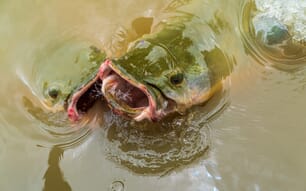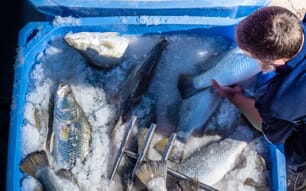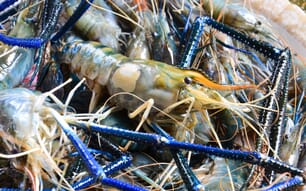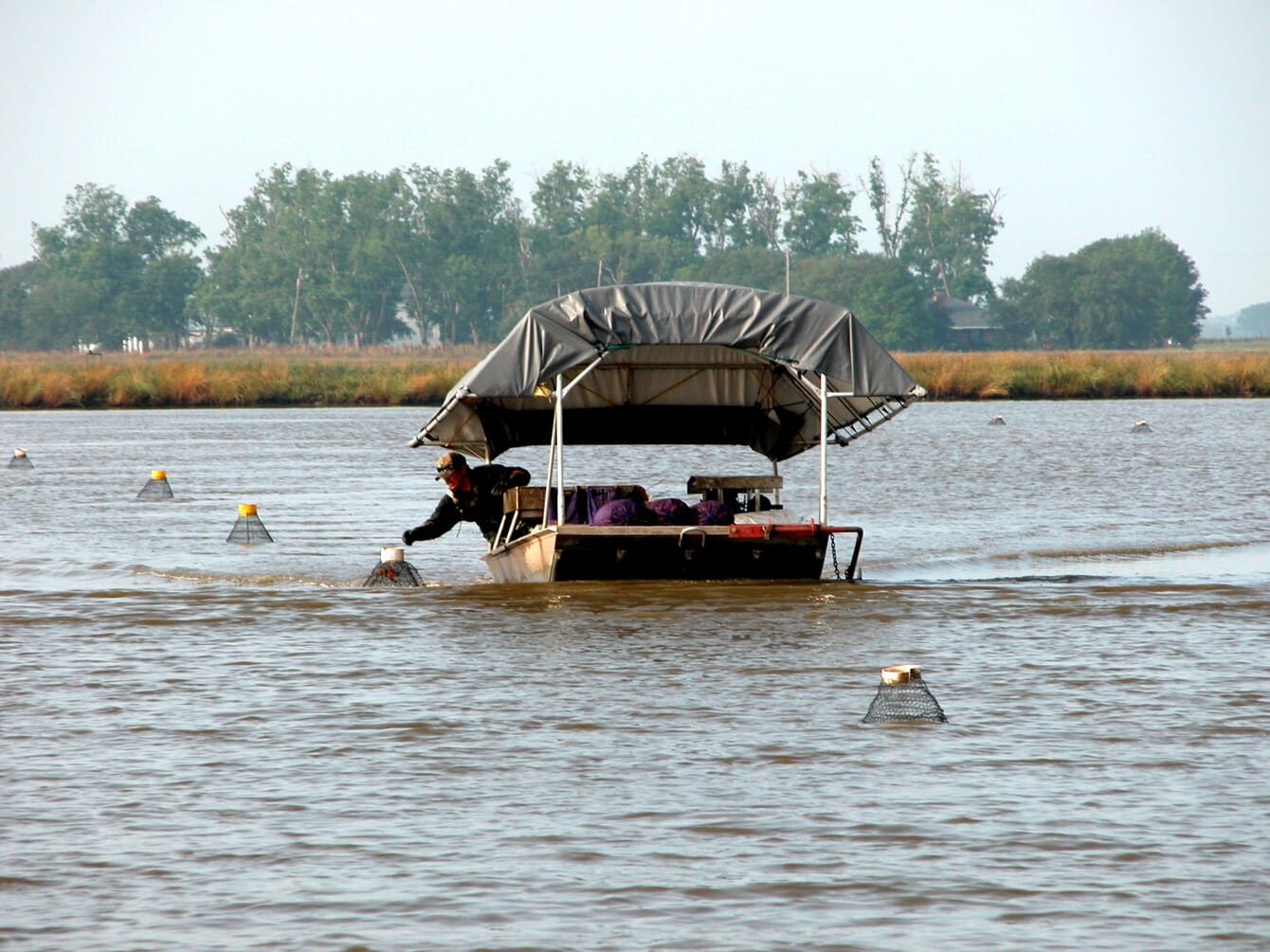
© Greg Lutz
Over the past decade, crawfish (often known as crayfish outside the US) production in Louisiana and the surrounding region has grown to become, arguably, the second most valuable sector in US aquaculture behind only catfish. This low-input, environmentally sustainable industry is based on management practices that mimic natural hydrological and vegetative cycles. It is also, however, greatly influenced by the weather and when normal precipitation patterns are disrupted crawfish populations (and harvests) can be significantly impacted. This 2023- 2024 season is a sobering illustration of how severe those impacts can be.
Crawfish aquaculture: how it works
To understand the impact of the drought it is first essential to understand the farming process.
Crawfish ponds and many rice fields – 70 percent of Louisiana’s crawfish aquaculture is conducted in rotation with rice production – are partially flooded and stocked in the spring with mature adult crawfish. The red swamp crawfish (Procambarus clarkii) is the predominant species in culture ponds, and natural reproduction is relied upon as a source of hatchlings each farming season.
Soon after stocking, the crawfish burrow along the levees to reach wet, saturated soil below the surface. Then they plaster and seal their burrows from the inside to trap and conserve water for the months ahead. Burrow openings are typically sealed with plugs of clay soil that soon become very hard. These plugs require significant rainfall to soften them enough for crawfish to leave their burrows. In permanent ponds used only for crawfish production year after year, burrowing is most common in the spring as water temperatures rise. Mild temperatures and frequent rainfall improve burrowing success.
As summer progresses in ponds with rice rotation, rice is harvested for grain and the stubble begins to regrow. Alternately, in crawfish-only management, a forage crop of late-planted rice or natural vegetation is cultivated. In either case, this takes place while the crawfish pass the summer months sealed in their burrows. Very low oxygen is typical within burrows, and high temperatures can worsen these conditions. While still in their burrows, a few female crawfish begin to lay eggs as early as late August. Water must be present in the burrow for successful egg laying, so regular rainfall is important over the summer to maintain some soil moisture and keep the pond banks from cracking.
Egg laying reaches a peak in early October. Normally, a female crawfish’s eggs hatch while she is still in her burrow and the young remain attached to, or clinging to, her tail until she eventually emerges. Ponds and rice fields are typically flooded from late September through late October to create a suitable environment for newly hatched crawfish. During this period, heavy rainfall events prompt females with eggs or hatchlings to leave their burrows, as their plugs become soft enough to push open. All across the crawfish producing region, folks know “the mama crawfish don’t come out until they hear the thunder”.
After ponds or fields are flooded in the autumn, the rice stubble or other vegetation that grew during the summer begins a gradual breakdown process, supporting a natural food web that can typically produce between 400 and 1,000 kg of harvestable crawfish per ha over the following seven to eight months. Depending on several factors, mainly temperature and dissolved oxygen levels, hatchlings will grow to marketable size in eight to 16 weeks, with peak harvests from March through May. Freezing temperatures rarely kill crawfish; they simply wait for the water to warm up so they can start moving and growing again. However, harsh winter conditions often eliminate any vegetation remaining above the water surface, significantly reducing food resources for the remainder of the season.
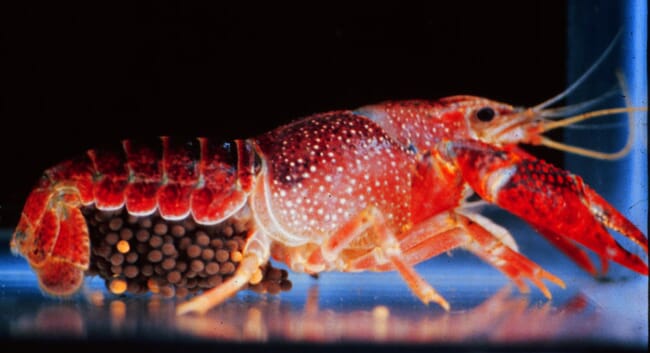
The impacts of the drought
Louisiana began to experience drought conditions in the late spring of 2023, and the situation became increasingly worrisome as summer progressed. As early as mid-August of 2023, Extension personnel with the Louisiana State University Agricultural Center (LSU AgCenter) were warning crawfish producers of potential problems ahead. At that time, the major concerns were cracking soil, saltwater intrusion in irrigation canals, and loss of vegetative crops needed to fuel the crawfish food web throughout the season. Under drought conditions, if the surrounding soil cracks and allows outside air to enter a crawfish’s burrow, the water inside will evaporate and the crawfish will die.
In the 1990s, AgCenter researchers excavated over 100 crawfish burrows, and found dead crawfish only in burrows with no remaining water. They established that dry summer conditions result in significant reductions in crawfish populations. And AgCenter research published in 2004 determined that 71 percent of the variability in crawfish crops from 1993 to 2002 could be explained by precipitation levels at three locations in Louisiana’s crawfish-producing region.
As drought conditions intensified going into the autumn of 2023, it became apparent that many producers in the southwestern region of the state, who normally rely on surface water from natural watersheds and irrigation canals, would be unable to flood their ponds at all, due to excessive salinity caused by saltwater intrusion. Many producers in other regions were also unable to flood their ponds due to low water levels. Total rainfall from May 2023 through October 2023 was, on average, down nearly 44 percent from the previous four-year average and average daily high temperatures were nearly 1.7o C higher.
By November, between un-flooded acres and negative impacts on crawfish populations, AgCenter economists predicted drought-related losses totaling $139.8 million for the 2023-2024 season. They determined that lack of suitable water sources prevented production for some 18,750 ha and that another 18,500 ha would fail to produce sufficient quantities of marketable crawfish to justify harvesting. However, drought conditions persisted through the month of November, further aggravating the situation. An analysis of eight years of harvest data from six ponds at the AgCenter’s Aquaculture Research Station had established that, across all years, precipitation levels in October and November had a statistically significant positive effect on monthly crawfish harvests.
And in another previous study, AgCenter researchers documented strong relationships between crawfish emergence (with eggs or young) and rainfall events, concluding that lengthy periods of low (or no) rain in the fall are problematic because large percentages of crawfish carrying their young emerge only after sufficient rain. In the fall of 2023 most producers reported no young-of-the-year crawfish in their ponds until early December, when many areas in the crawfish-producing region experienced a significant rainfall for the first time in months. In a normal year, early hatched animals would already be approaching harvestable size by that time.
The current situation
The weeks leading up to Easter are normally when Louisiana’s crawfish producers realise the highest revenues of the season. Distributors, retailers and restaurants typically purchase and re-sell some 35,000 tons of crawfish during lent, but many of these businesses remain closed due to short supplies and high prices. Tricia Benoit, with D&T Seafood in Abbeville, told The Louisiana Illuminator on 18 March: “This week last year, I would be buying anywhere from 1,000 to 1,200 sacks a day, now I buy about 300 sacks a day.”
Generally a rite of spring in Louisiana, many crawfish-themed events are being downsized. The organisers of the annual Downtown Lake Charles Crawfish Festival announced its cancellation altogether, citing the difficulties facing the industry this season.
Although harvests have risen to roughly 25 percent of what would be normal for this time of year, total production prior to March was only 5-10 percent of the typical amount, with early season prices reaching $10 per pound, twice as high as those in recent years. As young of the year crawfish that entered ponds after widespread rains in early December are finally reaching harvestable size, prices have begun to drop. But most producers and industry observers agree that prices are barely enough (and in some cases not quite enough) to cover costs associated with harvesting. Roughly half of Louisiana’s crawfish producers are actively harvesting at this time, but many may be forced to drain their ponds early if prices continue to decline.
David Savoy, a crawfish producer and long-time chairman of the Louisiana Crawfish Promotion and Research Board (LCPRB), shared his views on the supply and demand situation facing the industry.
As he explained: “Harvests have picked up, but they are nowhere near to making up for losses so far. The industry as a whole did not make money up until now, even at $8 per pound. Farmers just survived. Some areas throughout the region are doing OK, but many are not.
“There is a misconception that the farmers are price-gouging, but consumers need to lose the perspective that the farmer sets the price of crawfish. Crawfish producers can’t continuously stay just on the edge of making a profit. This season it’s virtually impossible for farmers to make a profit. The difference between farm-gate and retail prices is excessive, but the public generally does not buy directly from farmers.
“Middlemen have their place in the market, but they have a much lower investment and much higher returns than the farmers. Many buyers have no loyalty whatsoever; they assume there will always be someone else down the road with crawfish to sell.”
The LCPRB generates funds through voluntary assessments on bait and sacks consumed by the producers themselves. On a good year, these “check-off” funds can total $200,000 or more.
Savoy noted that: “The Board has some cash reserves on hand, but they will need to adjust their spending. There will also be pressure on many producers to avoid the assessments. There are a lot of farmers who have already cut every corner they possibly can. The Board is aware that assessments will also be lower than normal next season. The populations are just not there.”
Some farmers, generally in low-lying or more northerly regions, are having a better season, with harvests almost reaching average levels. JB Hanks, chairman of the Farm Bureau Federation Crawfish Committee is among these producers. His crew is currently fishing 8,000 traps per day. While the catch is only 0.12 kg per trap on average, Hanks shared that “at these prices it’s profitable, and harvests will probably pick up more in the coming weeks.”
He noted that “one downside to having a decent population is more predators (birds, furbearers) concentrating their efforts on the farm because most operations have little or no crawfish for them to consume.”
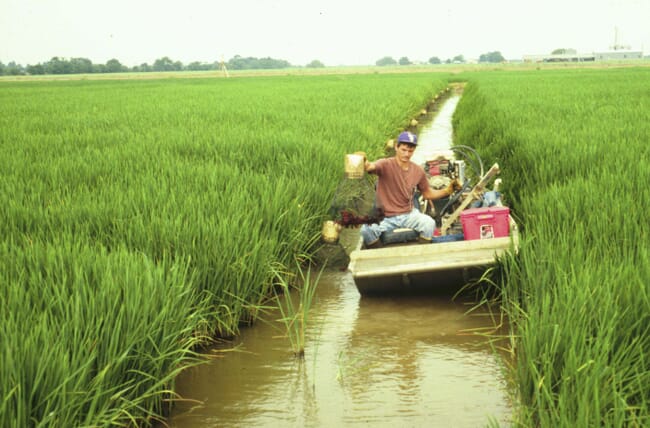
© Greg Lutz
Eric Scearcy, a farmer in the eastern-most area of the crawfish producing region stated he had never seen as many birds as he has this season.
Hanks pointed out some existing constraints to profitability that current conditions have exacerbated. Current harvest methods are labour intensive and simply not efficient, the available baits on the market are only moderately effective, especially in cold weather. He added that “crawfish, by acres and number of farmers, is the largest aquaculture sector in the US. Research support is needed at both federal and academic levels, and disaster relief programmes must be adapted for this industry.”
On March 6 Louisiana Governor Jeff Landry issued a disaster declaration, as required by the Small Business Administration (SBA) to formally authorise financial assistance for the industry. The SBA subsequently announced that individuals and businesses affected by drought impacts on the crawfish industry are now able to apply for Economic Injury Disaster Loans. Although these loans come with very generous terms, the last thing many producers and retailers want is to go further into debt.
In Washington DC, members of Louisiana’s congressional delegation have urged federal officials to grant a formal disaster declaration for the state’s crawfish aquaculture industry. In 2021, when the Covid pandemic led to industry losses, US Department of Agriculture (USDA) Secretary Tom Vilsack expanded previously established livestock aid programmes to include assistance for crawfish farmers. And so, while some drought relief programmes administered by the USDA may eventually provide some financial assistance, most industry observers agree it will not be nearly enough to offset the catastrophic losses many producers are facing.
And another problem will be facing many crawfish producers in the next few months. Crawfish populations will have to be re-established in the 37,000+ ha that were not in production this season. This typically requires 45 – 70 kg/ha of mature broodstock, which may be hard to come by at any price. Crawfish will also be needed to stock the roughly 73,000 ha that would normally be in rice-crawfish rotation. David Savoy opined “The production and quality are a month and a half behind. We may run out of crawfish before the season ends.”
In summary, Louisiana’s crawfish aquaculture industry will experience impacts from the 2023 drought for several seasons before an economic recovery is complete. Should drought conditions return before that takes place, the industry will be drastically transformed from the one we have come to know.


